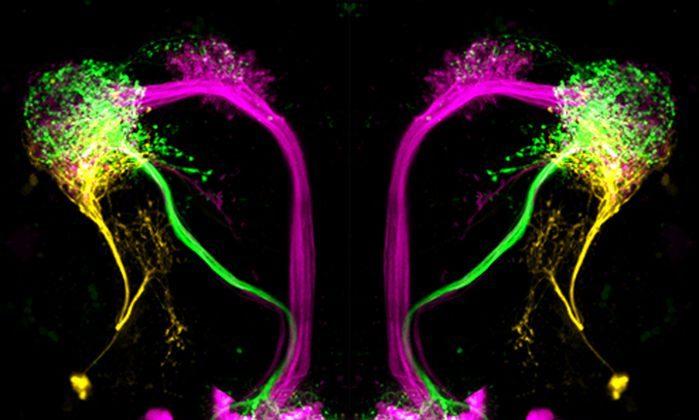Whether an odor is pleasant or disgusting to an organism is not just a matter of taste. Often, an organism’s survival depends on its ability to make just such a discrimination, because odors can provide important information about food sources, oviposition sites or suitable mates. However, odor sources can also be signs of lethal hazards.
Scientists from the BMBF Research Group Olfactory Coding at the Max Planck Institute for Chemical Ecology in Jena, Germany, have now found that in fruit flies, the quality and intensity of odors can be mapped in the so-called lateral horn. They have created a spatial map of this part of the olfactory processing system in the fly brain and showed that the lateral horn can be segregated into three activity domains, each of which represents an odor category. The categories are good versus bad, as well as weak versus strong smells. These categorizations have a direct impact on the behavior of the flies, suggesting that the function of the lateral horn is similar to that of the amygdala in the brains of vertebrates. The amygdala plays a crucial role in the evaluation of sensory impressions and dangers and the lateral horn may also.

“We were very surprised to find that the lateral horn, which is a brain region as big as the antennal lobe (i.e. the olfactory bulb of insects), can be segregated into only three activity domains, while the antennal lobe consists of about 50 functional units,” Silke Sachse, head of the BMBF Research Group, summarized. “Our results show that the higher brain is representing categories of odors, i.e. good versus bad odors, rather than the identity of an odor, which is represented at a lower processing stage such as the antenna and the antennal lobe.”
Like many other sensory networks, the olfactory circuit of the fly contains spatially distinct pathways to the higher brain consisting of excitatory and inhibitory projection neurons. Projection neurons are nerve cells that transmit sensory signals to other regions of the nervous system. Notably, the inhibitory projections, which were examined in this study, convey olfactory information from the antennal lobe, the first processing center, to the lateral horn exclusively and bypass the mushroom body, which is the center for learning and memory. The inhibitory projection neurons can be subdivided into two morphological groups: the first subset processes information about whether an odor is attractive or repulsive, and the second subset processes information about the intensity of an odor. To test the functionality of these neurons, the scientists worked with flies in which these neurons had been silenced.
The researchers believe that the function of the lateral horn in fruit flies can be compared to that of the amygdala − two almond-shaped nuclei − in the brain of vertebrates. In humans, the amygdala plays a primary role in the emotional evaluation of situations and the assessment of risks. If the amygdala is damaged, humans fail to show fear or aggression. However, lesions in the amygdala also prevent vital flight or defense reactions from being triggered. The scientists hypothesize that damage to the lateral horn may have similar effects on fruit flies. However, this assumption is so far speculative because the lateral horn could not be selectively inactivated.
In their study, the Max Planck researchers identified the lateral horn as the processing center for odor information that triggers innate odor-guided behavior. Good and bad odors are spatially decoded in different regions of the lateral horn. Further experiments will be needed to find out how this spatial map is finally transformed into the insect’s decision to act. The scientists are currently in the process of identifying higher-order neurons in the lateral horn to complete the olfactory circuitry from the periphery up to the brain centers where the decision is taking place that leads to purposive odor-guided behavior.
Original article can be found here.
